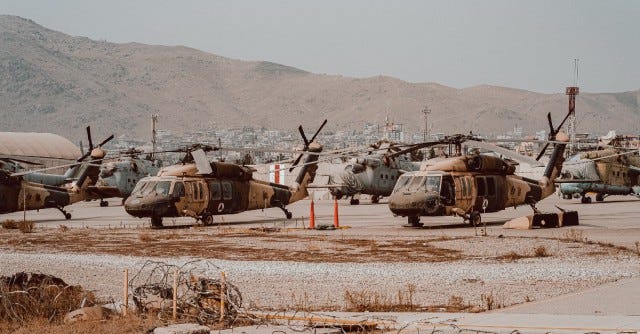“Life has no meaning. Each of us has meaning and we bring it to life. It is a waste to be asking the question when you are the answer.”
― Joseph Campbell
TALIBAN BUILDING ITS 'AIR FORCE,' CLAIMS TO HAVE REPAIRED HELICOPTERS BLISTERED BY AMERICANS
Months on, and the military side of Kabul’s Hamid Karzai International Airport (HKIA) remains a strangely silent place, littered with remnants left behind in the aftermath of the frantic U.S. exodus after almost two decades of war: MRE’s in heaping piles of trash, blistered U.S. warplanes, and a few lonely Taliban members on the security lookout.
But behind the large warehouses, mechanics are working on getting some of the U.S.-decimated aircraft back up and running. As we saw, there are several Russian MH-17s and U.S. Blackhawk helicopters that appear operational.
“We have repaired more than 50 helicopters. We have many types, and when we saw them flying overhead (during the war), we called them in our own names,” says Abdul Hadi Hamdan, 35, Director General of Kabul Airport, which they no longer refer to as “Hamid Karzai.”
Hamadan, who joined the Taliban in 2005, came to his esteemed position because it was proven he was a “trusted” person who had “served the country and did not cheat the elders.” He claims all issues with their aircraft “have been resolved.”
“When the Americans left, they did a lot of destruction in the military part. So it was a challenge for us, but the Emirate has its own engineers and technicians,” he continues. “We also had (engineers) from the previous government, so they have been doing the work.”
However, in the weeks and months before the Department of Defense (DoD) destroyed millions worth of U.S.-issued equipment given to Afghan Security Forces on its way out, the Taliban, as it stormed through and took control of strategic airbases from Herat and Mazar-e-Sharif to Kandahar and Kunduz, seized top-notch American equipment.
All that has amounted to an impressive arsenal of goods that the new regime, officially called the Islamic Emirate of Afghanistan, is feverishly purporting to keep functioning. Furthermore, Hamdan says they are working to return dozens of aircraft flown to neighboring nations amid the tumultuous August takeover.
“The Islamic Emirate of Afghanistan is working on reestablishing all security organizations needed. The Air Force is a priority for the country,” stresses Naeem ul Haq Haqqani, the 37-year-old Director of Information and Culture in Herat. “We are looking at different options to discuss and negotiate, and working towards having an air force.”
Throughout the 20-year occupation, the Afghan Air Force was considered one of the few success stories and the one battlefield unit that the Taliban did not possess throughout its insurgency years. Nevertheless, within days of the American departure, the Emirate deployed a cadre of engineers, technicians, and experts to revive at least some of what was left behind. On a visit to the Ministry of Defense (MoD) in the early weeks of the Taliban’s governance, scores of former government employees were lined up beside the delipidated gardens to get their old jobs back as unemployment soared and the economy crumbled.
“The aircraft that needed small repairs have been fixed, and those with major issues are being worked on,” quips Enayatullah Khwaraizmi, the 27-year-old spokesperson for the Ministry of Defense (MOD) run by Mullah Mohammad Yaqoob, the 30-year-old son of Taliban founder Mullah Mohammad Omar. “Previous government experts are back.”
Taliban spokesperson Bilal Karimi also affirmed the government immediately set about “building an airforce” after announcing a “general amnesty” for all former employees – calling on them to return to their positions and “help their country.”
Those experts, of course, were trained by the best of the best U.S. forces.
However, Khwaraizmi did not seem to know the difference between a Chinook or a Blackhawk, asserting that preferred aircraft was a decision of the Emirate’s political leadership, not the MoD.
But just days earlier, the Kabul skies were filled with the rare sounds of choppers flying overhead amid an ISIS-K attack on the Sardar Dawood Khan Military Hospital. The Taliban managed to use one U.S. Blackhawk and two Russian Mi-17s to dispatch a cadre of its “special forces” onto the roof as the standoff continued.
One chief Kabul-based Taliban intelligence official, who spoke on anonymity, explained that their Air Force – which he referred to as obligatory for any country – will be used in urgent situations and “based on need.” Previously, government leaders were flown from place to place. But under the Emirate’s banner, their leadership ventures via road.
Whereas the Afghan forces bolstered by NATO depended on the foreign footprint for advising and assisting, Khwarazami insists that the Taliban’s version of an airforce will be “fully independent.”
That may be easier said than done. So what does the Taliban have in their arsenal?
In early November, the Taliban held an impromptu Sunday afternoon military parade in the capital – fashioned by roughly 250 soldiers brandishing American M117 armored vehicles and M4 rifles – to show off its current evolution from insurgent into fully-functioned armed forces. But policing overhead was a flock of M1-17 helicopters. In addition, images have circulated of foot soldiers posing beside an A-29 attack plane and an MD-530 utility helicopter in the northern city of Mazar-e-Sharif, which fell to the Taliban’s hands the day before Kabul.
While no one can say for sure who and what their role inside Afghanistan is, the Russian Embassy is one of the few remaining open. Its group of apparent personnel and/or contractors on the ground are occasionally seen frequenting military clothing and supply shops, which sell off whatever was left behind.
“There are still security people coming in,” says one tactical store worker, who requested his name not be used. “The Russians are still here.”
At the fall, it was estimated that the Taliban possessed at least 38 airplanes, a dozen helicopters, and some unmanned aerial vehicles still in running condition. However, one senior Taliban commander later told me that even though they have the expertise to develop a drone program, they lacked sufficient equipment.
THE ROLE U.S. FEDERAL MARSHALS AND ROBERT DE NIRO PLAYED IN CATCHING ONE OF ITALY'S MOST WANTED MEN
The attack remains one of the most devastating on European soil and is etched in the collective memory of all Italians.
As locals and tourists sought to escape the sweltering heat inside Bologna Centrale railway station on the morning of August 2, 1980, a suitcase bomb exploded inside the overcrowded waiting room. It obliterated almost the entire building, and a waiting train, in a matter of seconds.
A total of 85 people were killed, more than 200 severely injured, and thousands were trapped in the burning rubble for several hours as passersby attempted to offer aid amid the apocalyptic scene.
Members of an Italian neo-fascist terrorist group known as the Nuclei Armati Rivoluzionari (NAR, Armed Revolutionary Nuclei) were later sentenced for the attack, although they denied any involvement. In the immediate aftermath, many top-tier members fled.
Stefano Procopio was one of the first to abscond - using a fake passport - and arrive in Lebanon to train emerging Christian militia groups. He ended up on Interpol's Red Notice as one of Europe's most wanted men for thirteen years, until U.S. federal authorities stepped in, with some inadvertent help from Hollywood A-lister Robert DeNiro.
"An international Red Notice was issued through Interpol some years before, and the U.S. Attorney requested the Eastern District of N.Y. to up the case," recalled Craig Caine, a then New York-based inspector for the U.S. Federal Marshals (USMS) who partnered with Lenny DePaul. "I was given Carte Blanche (by the late Supervisory Deputy U.S. Marshal Mike Hollander) to pick a team and run with it."
USMS investigators tracked the mother's phone in Italy using a reverse trap and trace. Following information from the trace, investigators located two addresses, one in the Bronx and one in Manhattan, right across the street from Robert De Niro's still standing restaurant, The Tribeca Grill.
"If he was indeed here, we didn't know if he was planning another terrorist act, so we pulled out all the resources we had available," Caine continued. "We received information that the mother had called both the Bronx and Manhattan phone numbers, and through investigative work, we were able to ascertain that the phones were subscribed to a female."
Pre-911 days of information sharing between countries "at the speed of the internet" did not exist, and their intelligence gathering relied heavily on tracking coin phones and trying to track pre-paid cards and odd movements.
Investigators learned that a woman used an apartment in the Bronx, New York, and had a Jeep with New Jersey tags. About 30 investigators were assembled, including Marshals, NYPD, DEA and Customs, to start surveillance on both locations. Also on standby were the NYPD Bomb Squad and Emergency Service Unit.
"To complicate the situation, President Clinton was due to arrive in New York – just a stone's throw from where we believed Procopio was staying in Manhattan," Caine said. "We contacted the Secret Service to advise them of our plan of action. The S.S. took this very seriously and supplied a Counter Assault Team. Since we had no idea what might happen, S.S. agents deployed snipers on various rooftops and stationed extra agents in sensitive positions in and around the area."
However, the most critical view of the target was De Niro's restaurant, with his fame from his silver screen roles seamlessly woven into the arrest plan.
"We convinced (restaurant) management to supply a few waiters' uniforms and we also placed personnel having lunch in the outdoor seating area," Caine explained.
Caine and De Paul had teams watching the Bronx apartment, and they had been told the woman had gotten into the Jeep with several boxes that contained unknown contents, and was heading towards Manhattan on the West Side Highway.
"We knew Procopio was a trained killer; it was as simple as that. The groups around then didn't care how many people they killed; they didn't want to blow up just one or two. They loved to send that message (of power)," DePaul said. "He knew his day was coming, and we had no idea what kind of threat we were looking at."
The suspicious Jeep pulled up to the Manhattan target location. The woman sat inside. A person matching Procopio's description emerged from the building and walked towards the Jeep, Caine recalled.
"The agents and detectives sitting in De Niro's restaurant put a positive I.D. that this was our guy," he said.
Caine decided it would be safer to capture the suspect as soon as possible, before he could get his hands on one of the boxes, after the team debated whether to attack both locations simultaneously or wait and see what happens. Upon receiving the dispatch, all units converged on the target, and the streets erupted in action. Cars began flying up one-way streets in all directions. The agents in waiter uniforms revealed raid jackets, handguns, shotguns, and machine guns pulled by dozens of authorities from every angle.
Caine remembered how Procopio struggled for a little while as another officer got him to the ground. He finally gave in to being cuffed.
"Catching my breath, as I looked around, I heard clapping. There were all these tourists standing around applauding and snapping photos. It turned out De Niro's is a major tourist attraction, and they assumed it was a scene from a movie," Caine pointed out with a laugh. "They wanted to know when Robert De Niro was going to show up; I said,'stick around because he was getting his make-up put on for the next scene,' and we bolted. This was the first and only time I received a standing ovation for just doing my job."
As it turned out, Procopio was using the boxes to move locations – representative of life on the run – but as DePaul reflected putting the cuffs on him, what stared back were tired eyes.
"Around us were all these people in DeNiro's restaurant applauding us," he went on. "Most of these guys in that world are straight-faced and have no eye contact, but Procopio wasn't shy. He was very nervous in the backseat of my car. I think he was more shocked than anything else that we finally caught up to him. He was running a long time – and I guess he became complacent."
In his plea, Procopio did not challenge extradition. The Italian authorities quickly arrived with a doctor on hand to administer sedatives if necessary. After passing through security, he was escorted to the JFK Airport tarmac.
"The threat was a very real one, but this was a case where multiple agencies here and in Italy came together and shared information, something that became a crucial concept after 9/11," DePaul observed. "It was an intense case, a lot of sleepless hours – but we at least got our part of the job done."
It remains an unsolved case more than 40 years after the bombing.
What exactly happened, and the role played by the leftist, rightist, and Middle Eastern elements in destabilizing Rome's leadership, remains a subject of ongoing speculation. It was not until earlier last year that an Italian court determined it was a "state massacre" and subsequently issued a life sentence to a fourth NAR member.
A second twist in the tale came in last February, when Italian prosecutors determined they had gathered enough evidence to rule that Federico Umberto D'Amato, who rose through the WWll ranks, but later became one of the nation's foremost food critics, funded the attack.
D'Amato, who died in 1996, is believed to have moonlighted as a right-wing terrorist financier who designed bombs that could be attributed to left-wing extremists.
Exactly who planted the device inside the suitcase on that fate-filled day remains unclear.
Bologna remains one of the most horrific terrorist attacks in Europe, and much of the evidence has been classified. At the station, the looming clock tower, the only structure left after the tragedy, still stands.
It remains frozen in time, at 1025 local time, marking a moment when lives were lost and forever changed.
Check out my interview with Mike Ritland on Mike Drop’s Podcast.
For those interested in learning more about the aftermath of war, please pick up a copy of my latest book “Only Cry for the Living: Memos from Inside the ISIS Battlefield.”
Also if you want to support small business:
And also now available Down Under!
Thanks again for your support. Follow me on Instagram and Twitter for more updates

















Share this post